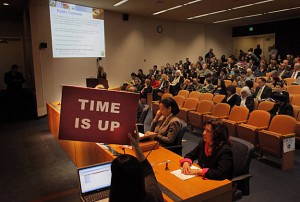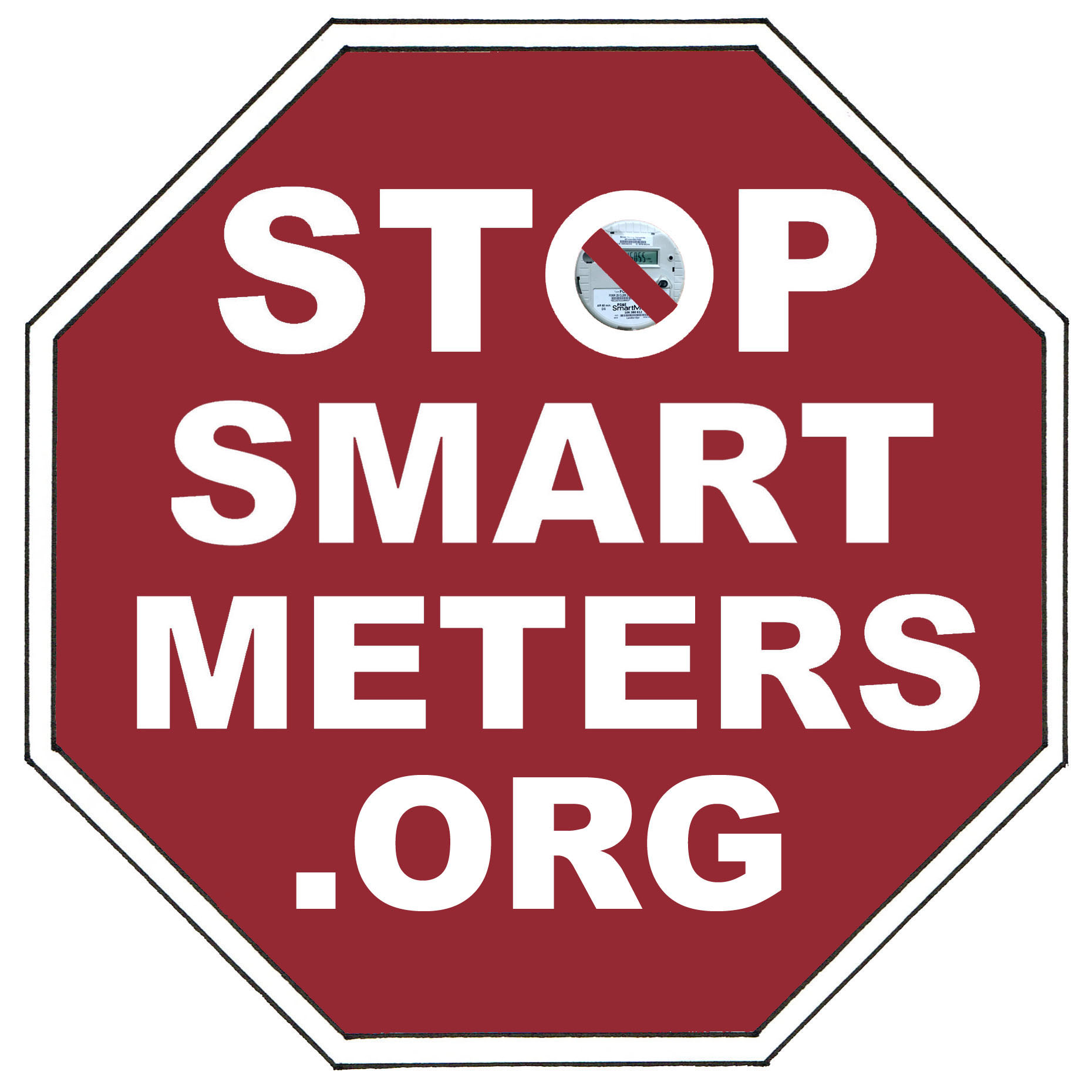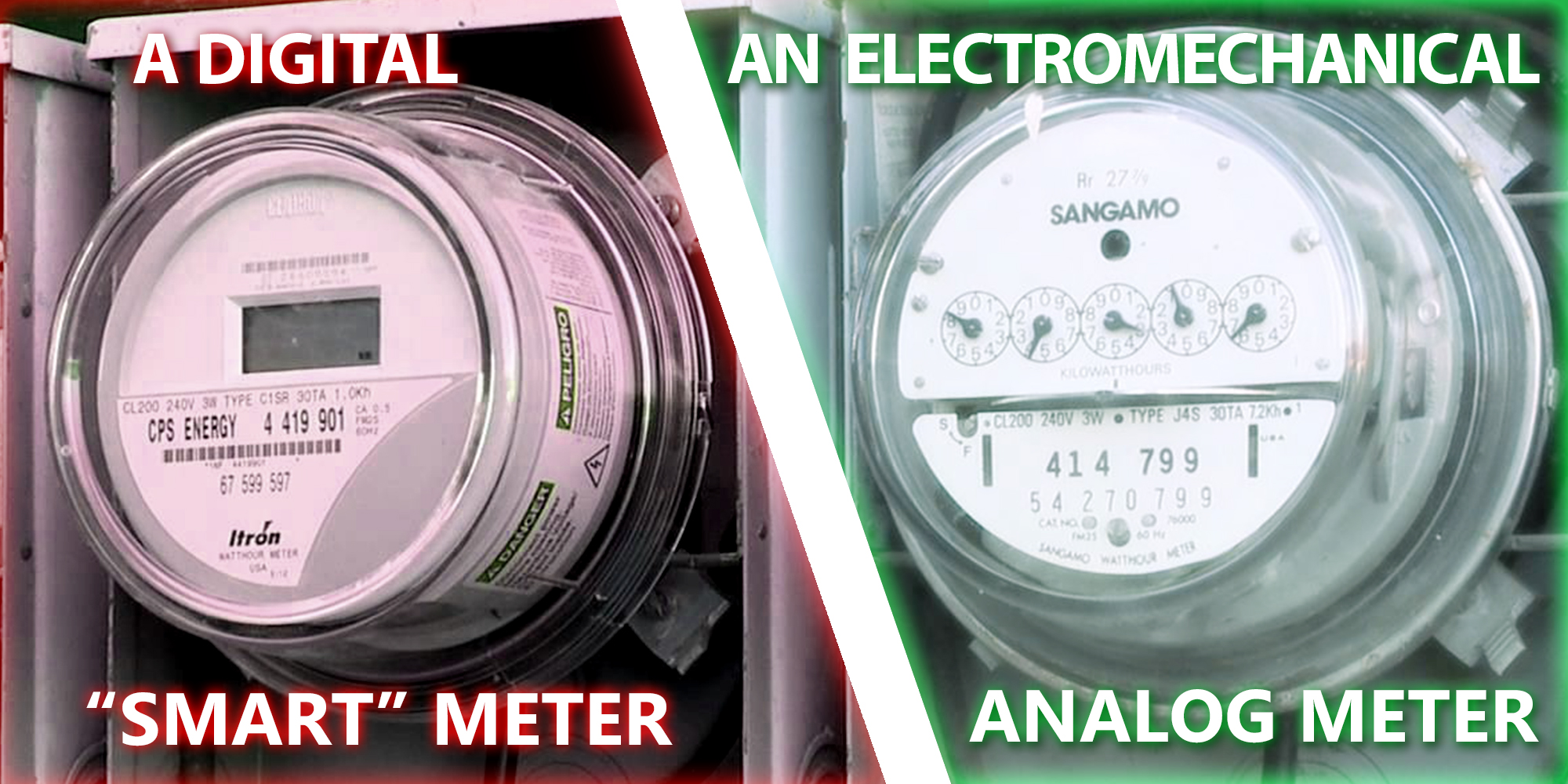
Note: We've had a request to remove the previous photo that depicted Mr. Peevey as Pinocchio, due to the fact that the president of the CPUC apparently suffered from cancer of the nose. We'd like to point out that our removal of this photos demonstrates far more respect than Mr. Peevey has ever shown- through his policies- to victims of the smart grid, including cancer victims. -Ed.
We have been saying all along that this forced deployment of dangerous “smart” meters is illegal, and that the recent proposed “opt-out” put forward by CPUC President Michael Peevey is extortionate—here is a detailed analysis of just how far away President Peevey steps from what he and his commission are actually allowed by Federal law and Public Utilities Code to do. Peevey uses laws that should in fact protect consumers and allow them choices–instead twisting them to protect the interests of profiteering utility corporations.
The analysis comes to us from Steve Martinot (of Alameda County Residents Concerned About Smart Meters (ACRCASM)), who has been involved as a protestant in the CPUC’s opt-out legal proceedings since the beginning. We at Stop Smart Meters! are not legal experts, but we think Steve has done a good job of being a citizen-lawyer, and simply reading with care the CPUC code and the Federal law in question with care. Here is Peevey’s 47-page decision.
Peevey’s proposal twists the law in order to make it look as though the Commission has a right to mandate ‘smart’ meter installation. The law as written already protects us from forced installation, Martinot finds: “We need to be calling for the PUC to obey the law, to stop being a law-breaking agency.” Please read Steve’s analysis in full below–it is long, but we hope it can help in the fight against ‘smart’ meters here in California and elsewhere.
__________________________________________________
Peevey’s Proposed Opt-Out in Clear Violation of CPUC Code and Federal Law
You may be aware that the opt-out proposal is extortionate. And you may also be aware that there is no legislation that directly mandates installation of smart meters. But in CPUC President Peevey’s proposed decision, issued Nov. 20, 2011, he actually warps the law to make it look as if there is.
There are three levels to this issue: the policy level of time-variant pricing; the infrastructure that will make this mode of pricing available to people (available, not mandatory); and the technology which will constitute this infrastructure, of which smart meters are a part–the part that impacts people.
Now let me briefly describe Peevey’s reasoning, and then show how it warps the law—laws that he himself cites—so badly as to turn it into its opposite. We need to understand this in order to direct our opposition at what they are doing, and not just at what they are doing to us.
We have been calling for the PUC to change its policy. But if the law already protects us, then we need to be calling for the PUC to obey the law, to stop being a law-breaking agency.On page 21 [of this document], Peevey says:
“To ensure that the electric noncommunicating meter [the type of digital non-RF meter proposed for opting out] is able to take advantage of smart grid benefits in the future, it must be capable of capturing interval energy consumption data,” that is, time-of-day data.
Look at his syntax carefully. “To ensure that the … meter is able to” benefit from something. That is, he is addressing the necessity of a certain technology in order that the smart grid infrastructure will be available in the sense of capacity or capability. Available to whom? He says it has to be available to the meter, which implies that it must be available to the customer, but he means that it must be available to the utility. His argument is that the technology “must be capable” of acquiring time-interval data in order for “smart grid benefits” to be available. “Must be capable.” That is his wording. Read it carefully.
This is his argument; this is why he has chosen a digital non-transmitting meter for opt-out, and why he rejects leaving analog meters in place or replacing them. (Ultimately, those of us fighting these devices know, it is the billions of dollars involved in the technology, the construction, the profitability, the enhanced corporate earnings, that are the real reasons for all this, “why” he is doing it. But here I am dealing with his logic, as he presents it, because that is one of the fields we have available to us to confront him.)
Peevey says: “The single most important reason to transition from analog meters” is to support ‘price responsive tariffs.’” This is also known as time-variant pricing, or Time-Of-Use (TOU) pricing. Digital meters, ‘smart’ or not, are necessary to implement this type of pricing.
“We do not find the analog meter option reasonable [because it cannot] track interval energy consumption data.” The important point here that he conveniently leaves out is the use of “tracking interval data” must be left voluntary for the customer. (See below for the relevant law.) This is a serious twisting of the truth. He is lying by omission.
He goes on. “We find the appropriate opt-out option to be … a SmartMeter with the radio-off.” Here he is stating his installation mandate. It is contained in his insistence on an opt-out option. An opt-out option can be proposed as an exemption or exception only in the context of a mandated uniformity (of installation).
Why is all this important? Because the law states that time-variant pricing must eventually be made available. But Peevey is turning that law into a statement of mandate that the infrastructure must be in place in order to satisfy the legislative directive that the policy (time-variant pricing) be made available, that is offered, to those who want it.
The policy is to be voluntary, but the infrastructure is to be mandated in order to provide for that voluntary availability. He shifts “must be available” (the policy) to something else, namely, “must be capable” (the infrastructure). It is in that warping of logic that he can pretend to an installation mandate.
This point is vitally important because it implies, in my reading of the law, that every non-consensually installed smart meter is in violation of this law, the very law that Peevey uses to ground his idea of an installation mandate.
The law is clear. Federal law (Energy Policy Act of 2005) only says that Advanced Metering (smart meters) is to be made available, that is, offered to those who want it. California state law only says that time-variant pricing is to be made available, that is, offered to those who want it.
Indeed, the only field on which the PUC has regulatory authority with respect to customers is in the setting of rates. It can govern every aspect of a public utility, but the only aspect of the utility’s relation to customers that it can govern is that of rates.
Let me repeat: Peevey is saying that in order to be able to offer time-variant pricing, the infrastructure (smart meters) “must be” in place. It is by that slight of hand that he is transforming what is left voluntary in the law into a mandate in practice.
And he is dead wrong. The law provides for the opposite. The customer must have the ability to refuse the technology (smart meters) precisely because the policy (time-variant pricing) is refusable.
The law he cites is the Public Utility Code 745, which he mentions in a footnote to an odd statement in his proposed decision. He says, time-variant capability “must be available by January 1, 2014.” 2014 is a deadline for him. And his footnote says: “Pursuant to Pub. Util. Code § 745(b)(2) an electrical corporation may employ mandatory or default time-variant pricing, without bill protection, for residential customers after January 1, 2014.”
It sounds like he is using the law to mandate the installation of smart meters or time-variant meters in order to have them all ready for January 1, 2014, doesn’t it?
Here’s what section (b) of article 745 actually says:
(b) The commission shall not require or permit an electrical
corporation to do any of the following:
(1) Employ mandatory or default time-variant pricing, with or
without bill protection, for any residential customer prior to
January 1, 2013.
(2) Employ mandatory or default time-variant pricing, without bill
protection, for residential customers prior to January 1, 2014.
(3) Employ mandatory or default real-time pricing, without bill
protection, for residential customers prior to January 1, 2020.
Read it again. Don’t be fazed by the legal terminology. It really means what it says. The actual words of the law are: “shall not require or permit … any of the following.” It does not say “may employ,” as Peevey paraphrases it. That is a complete reversal of the law’s stated meaning.
And what is the purpose of installing a smart meter? It is to permit time-variant pricing. Around this idea of “permitting time-variant pricing,” Peevey has transformed “shall not” into a mandate. But the law says, “shall not permit.”
What this means is that, at least until January 1, 2013, and in general until January 1, 2014, there is no reason why any smart meter (or radio-off or non-transmitting digital meter) needs to be installed. There is no reason for a non-analog meter because there is no ability for the utility, under the law, to impose or establish a norm or standard of time-variant pricing, until January 1, 2014. There is no reason for removing analog meters since no electrical corporation can require technology capable of time-variant pricing because the utility cannot deploy default (i.e. the norm or standard) time-variant pricing, under this law, until January 1, 2014.
In other words, Peevey’s motivational argument for not affirming analog meters given above is purely invented, and has no basis in law. That is, it has no basis in law other than his own misquoting, or purposeful truncation in his law citation, a truncation that actually turns the meaning of the law into its opposite.
Peevey is operating as if the law says the opposite of what it actually does say. “The commission shall not require or permit … time-variant pricing …” But forcing the installation of a smart meter is a way of permitting time-variant pricing in practice. No permits need be issued because the smart meter itself is the permit. And as such, it is in violation of section 745(b).
Well, what happens after January 1, 2014? We get that in section (d). This law is not in any way obsolete; this version of the Public Utilities Act was passed in January of 2011.
(d) On and after January 1, 2014, the commission shall only
approve an electrical corporation’s use of default time-variant
pricing in a manner consistent with the other provisions of this
part, if all of the following conditions have been met:
(1) Residential customers have the option to not receive service
pursuant to time-variant pricing and incur no additional charges as a
result of the exercise of that option. Prohibited charges include,
but are not limited to, administrative fees for switching away from
time-variant pricing, hedging premiums that exceed any actual costs
of hedging, and more than a proportional share of any discounts or
other incentives paid to customers to increase participation in
time-variant pricing. This prohibition on additional charges is not
intended to ensure that a customer will necessarily experience a
lower total bill as a result of the exercise of the option to not
receive service pursuant to a time-variant rate schedule.
(2) Residential customers receiving a medical baseline allowance
pursuant to subdivision (c) of Section 739 and customers requesting
third-party notification pursuant to subdivision (c) of Section
779.1, shall not be subject to mandatory or default time-variant
pricing.
(3) A residential customer shall not be subject to a default
time-variant rate schedule without bill protection unless that
residential customer has been provided with not less than one year of
interval usage data from an advanced meter and associated customer
education and, following the passage of this period, is provided with
not less than one year of bill protection during which the total
amount paid by the residential customer for electric service shall
not exceed the amount that would have been payable by the residential
customer under that customer’s previous rate schedule.
Okay, let’s take a close look. Subsection (1) says: “Residential customers have the option to not receive service pursuant to time-variant pricing and incur no additional charges as a result of the exercise of that option.”
Yes, that is what it says. A customer cannot be charged for opting out of time-variant pricing after January 1, 2014. If we don’t have to accept time-variant pricing after January 1, 2014, then we will not need technology capable of it, and we can refuse both. Neither are mandatory.
So Peevey’s argument against leaving analog meters in place, or replacing them, is false.
After January 1, 2014, the customer can opt out of time-variant pricing, then the customer has no need of technology capable of it, and so, an analog meter will suffice, Peevey’s desires notwithstanding.
And before January 1, 2014, we cannot be required to accept time-variant pricing before, so we can refuse the technology capable of it during that time as well.
Under Peevey’s own logic that the technology is intimately connected to time-variant pricing, refusing the latter implicitly means the refusability of the former, under the same conditions (no additional charges).
When Peevey says, “To ensure that the electric noncommunicating meter is able to take advantage of smart grid benefits in the future, it must be capable of capturing interval energy consumption data,” he has done something he has no business doing—taking upon himself the necessity of “ensuring” anything with respect to “smart grid benefits.”
Indeed, there is a flexibility in the law that the PUC has ignored. Not only can there be no charges or administrative fees for refusing time-variant billing, and presumably its infrastructure, in the event that a customer wants to see if it works, that customer gets two years to try it out. It is on consignment. And there are medical baseline allowances. Nothing is mandatory here for the customer.
What does section (c) say? It says:
(c) The commission may, at any time, authorize an electrical
corporation to offer residential customers the option of receiving
service pursuant to time-variant pricing and to participate in other
demand response programs.
This section is saying that the utility can only offer this service. It is up to the customer to want it, that is, to opt in. According to this law, there is no necessity to opt out. Until January 1, 2014, there is only the option to opt in. Period. If a customer wants to use time-variant pricing, then they get the technology that allows them to do so (a smart meter). And if they don’t want to use that, they don’t need the technology to do so.
This is in accordance with the Federal Energy Act of 2005, which mandated that utilities had to offer AMI technology to those customers who might want it. And that was as far as federal law went. Neither it, nor state law, have mandated that any customer must accept this new AMI technology.
But that has been the problem we have been confronting all along, isn’t it? The PUC has been misreading the law, turning it around so that it means the opposite of what it says, and then using it against the people of California.
Now, what does “bill protection” mean? That takes us back to section (a) of this article, a section of definitions, where it defines “bill protection” and “time-variant pricing.”
(1) “Bill protection” means that customers on mandatory or default
time-variant pricing will be guaranteed that the total amount paid
for electric service shall not exceed the amount that would have been
due under the customer’s previous rate schedule.
This is self-explanatory. The term “mandatory” keeps showing up in this law, but given that the detailed conditions it enumerates all relate to residential customers, in terms of non-imposition and the voluntary nature of the programs, the term “mandatory” can only apply to non-residential customers. That is, businesses.
Bill protection simply means that with time-variant pricing, your total bill will be the same as previously. Between Jan 1, 2013 and Jan 1, 2014, the utility cannot require or permit time-variant pricing without this guarantee. A customer can opt in before or during that period, but that is up to the customer.
Conclusion
Every smart meter installed without the permission of the property owner up to today is not only prima facie evidence of trespass because installed in violation of PG&E’s (and other utility’s) easement. But it is in violation of this article 745 of the Public Utilities Act because, according to section (c), participation in the program must be voluntary. That means the will of the customer has to be canvassed.
For the PUC to have authorized the installation of smart meters without consent is in direct violation of the Public Utilities Act of California. Anyone in the PUC who has authorized or legitimized such consent-less installation is thus guilty of directly advocated violating this law.
To address one more of more of Peevey’s lies here. He says, “the FCC also regulates human exposure to RF emissions in order to protect public health and safety.” (p. 16 of the proposal) The FCC does no such thing. It regulates technological devices, and sets maxima for RF emissions, assuming that this will have no effect on health and safety. If the FCC were into protecting health and safety, it would pay attention to what happens to people in the field from exposure to RF emissions. But it doesn’t.
Steve Martinot (martinot4 [at] gmail.com) has been a machinist, truck driver, university lecturer, union organizer, underground newspaper editor, poet, writer, among other things. Currently the group he works with on this issue is the Alameda County Residents Concerned About Smartmeters (ACRCASM).









Thank you much ! Steve,
That really hits the nail on the head and is spot on.
I know it took a large amount of time and research to draft this post, and it is the most accurate argument against the new AMI meters that I have ever seen anywhere.
THIS IS EXTREMELY IMPORTANT, and no doubt that the utility corporations and the PUC’s have read it. Now, I hope it goes viral all across the country.
I might add that I still have my analog meter, and have no intention whatsoever of letting PG&E replace it, never did and never will, but given this reference, I feel even more secure now. PG&E can eat dung !
I cannot wait to read this article, and couldn’t agree more that what they’re doing is illegal. Maine has it right – smart meters should be opt-in only. That’s what the Federal Energy Policy of 2005 says. The language is straightforward. And, actually, smart meters shouldn’t be put on houses at all. They are untested for human safety. The FCC has no guidelines about non-thermal effects of radiofrequency radiation, so every time the power company says “The FCC says it’s o. k.,” it’s actually not. They are going down for this, and they going down big time. And the more of us that jump on board, the quicker it’s going to happen.
I just have a minute, and will have to read the article tomorrow. Just wanted to share some good news: Last night, my husband and I spoke in front of a local city council. The council, at the end of the meeting, talked about a resolution to at least ask for answers from the power company. After what I’ve seen from other cities, we were very heartened by that response.
We also distributed what I call “Smart Meter Survival Kits.” They are gallon size ziplocks with a sign inside that says “DO NOT REPLACE METER. We refuse the smart meter due to health and privacy issues.” Also inside are several sheets explaining what makes smart meters so dangerous, and numbers and websites that will help people either avoid getting a smart meter, or what to do if they already have one. We handed out around 40, and probably already have that many more people around here refusing a meter (I think and hope I’m seriously underestimating that number, since we’ve had a letter to the editor and an article based on a previous visit to another local city).
Keep up the good work, everyone. We are, slowly but surely, going to save as many people as possible from the smart meter debacle. They’re so bad that I think, eventually, every single one of them is going to have to be removed. And we’re going to speed up that process considerably!
And thanks, Redi, for your helpful posts. They are encouraging. (-:
It would be great to have that information and details on where you got the sign or how you made them and the text for the several sheets.
It would be good to have a link here to a nicely formatted information packet, maybe just one page that could be photo copied in mass and then mailed out to all your neighbors. Or simply rubber banded to their mailbox, or magnet attached.
They replaced mine today while i was at work. what can i do?
Just this past week I called in our meter reading due to many over estimated readings causing huge bills ,I ask the employee why are we paying for a smart meter when we do not have one ?.Her Reply,” oh you want a smart meter we will can get some one to help you they will get out there right away to get one installed “.I excitedly said No we do not want one we want to know why we are being billed for having one when we do not have one . She stated oh let me switch you to some one who can get it set up to get you one installed I said No I do not want one I want you guys to quit billing us for some thing we do not have .I ended the call due to holiday rushing but is there help out there for this ? How many people are dealing with this kind of issue ?
Pingback: CPUC Proposed Decision on Smart Meter Options could change « Burbank ACTION
Pingback: Illegal & Fatally Flawed: Proposed Opt-Out Should be Trashed | Stop Smart Meters!
A. it is a public secret that power companies pushed the governments to mandate smart meters and that this has nothing to do with benefiting customers in any way although customers will be paying for this expensive and immoral exercise. It is immoral because people are subjected to an experiment with to them known serious health consequences and without informed consent – people are forced to be lab rats whether they want it or not.
B. It is also a public secret that through means of power and money they have coerced legal and medical professionals into “obedience” and silence such that in Victoria all legal practitioners have the same excuse of “we can’t provide legal advice on how to refuse a smart meter” although they know legal grounds on which people can and shoud refuse smart meters. Medical professionals are similarly “advised” not to acknowledge any health issues as being related to smart meters and not to share it with patients BUT to only forward data to IBM for analysis. As IBM is paid millions to do this analysis and by power companies, it is unlikely IBM would publish any discovered statistics incriminating power companies and government of the smartgrid-imposing genocide.
C. StopSmartMeter activists seem to be inconspicuously infiltrated by moles (people paid to destroy from within and quietly dob to power companies and government).
Instead of relying on this site, all of you who are rightfully against smart meters should go door to door and collect signatures, evidence, statements, and rally in front of power companies, government, and health institutions demanding opt-out and demanding that all information about smart meters is disclosed to the public, including deadly confidentiality clauses.
So, the only way to stop this global wi-fi genocide is to have honourable, decent, and ethical medical, health and environmental professionals come forward willing to make statements in court, demonstrating the damage ongoing cumulative smart meter radiation exposure will do to human health.
http://www.youtube.com/watch?v=L7E36zGHxRw
http://www.youtube.com/watch?v=3LvSGYU_kG0
http://www.powerwatch.org.uk/news/20050722_bamberg.asp
http://www.wificoncern.org/concern11.html
Hello from the UK. I have a smartmeter on my water, and a “scanpad” installed on the outside of my home which reads the inside smart meter via an electric cable. The scanpad is read electronically, there are no numbers on it, and maybe it can be read remotely, so it must have a chip inside. I know it is all illegally installed because my landlord, the property owner does not know about it. They didnt bother asking him. I have removed the scanpad, and am working on the smart meter.
When I blogged about it, they became very interested in helping me.
Water should be free anyway.